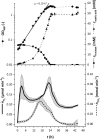It does not always take two to tango: "Syntrophy" via hydrogen cycling in one bacterial cell
- PMID: 32203116
- PMCID: PMC7242416
- DOI: 10.1038/s41396-020-0627-1
It does not always take two to tango: "Syntrophy" via hydrogen cycling in one bacterial cell
Abstract
Interspecies hydrogen transfer in anoxic ecosystems is essential for the complete microbial breakdown of organic matter to methane. Acetogenic bacteria are key players in anaerobic food webs and have been considered as prime candidates for hydrogen cycling. We have tested this hypothesis by mutational analysis of the hydrogenase in the model acetogen Acetobacterium woodii. Hydrogenase-deletion mutants no longer grew on H2 + CO2 or organic substrates such as fructose, lactate, or ethanol. Heterotrophic growth could be restored by addition of molecular hydrogen to the culture, indicating that hydrogen is an intermediate in heterotrophic growth. Indeed, hydrogen production from fructose was detected in a stirred-tank reactor. The mutant grew well on organic substrates plus caffeate, an alternative electron acceptor that does not require molecular hydrogen but NADH as reductant. These data are consistent with the notion that molecular hydrogen is produced from organic substrates and then used as reductant for CO2 reduction. Surprisingly, hydrogen cycling in A. woodii is different from the known modes of interspecies or intraspecies hydrogen cycling. Our data are consistent with a novel type of hydrogen cycling that connects an oxidative and reductive metabolic module in one bacterial cell, "intracellular syntrophy."
Conflict of interest statement
The authors declare that they have no conflict of interest.
Figures






Similar articles
-
The Rnf Complex Is an Energy-Coupled Transhydrogenase Essential To Reversibly Link Cellular NADH and Ferredoxin Pools in the Acetogen Acetobacterium woodii.J Bacteriol. 2018 Oct 10;200(21):e00357-18. doi: 10.1128/JB.00357-18. Print 2018 Nov 1. J Bacteriol. 2018. PMID: 30126940 Free PMC article.
-
Regulation of caffeate respiration in the acetogenic bacterium Acetobacterium woodii.Appl Environ Microbiol. 2007 Jun;73(11):3630-6. doi: 10.1128/AEM.02060-06. Epub 2007 Apr 6. Appl Environ Microbiol. 2007. PMID: 17416687 Free PMC article.
-
Dissection of the caffeate respiratory chain in the acetogen Acetobacterium woodii: identification of an Rnf-type NADH dehydrogenase as a potential coupling site.J Bacteriol. 2007 Nov;189(22):8145-53. doi: 10.1128/JB.01017-07. Epub 2007 Sep 14. J Bacteriol. 2007. PMID: 17873051 Free PMC article.
-
Energetics and Application of Heterotrophy in Acetogenic Bacteria.Appl Environ Microbiol. 2016 Jun 30;82(14):4056-4069. doi: 10.1128/AEM.00882-16. Print 2016 Jul 15. Appl Environ Microbiol. 2016. PMID: 27208103 Free PMC article. Review.
-
New Horizons in Acetogenic Conversion of One-Carbon Substrates and Biological Hydrogen Storage.Trends Biotechnol. 2019 Dec;37(12):1344-1354. doi: 10.1016/j.tibtech.2019.05.008. Epub 2019 Jun 27. Trends Biotechnol. 2019. PMID: 31257058 Review.
Cited by
-
A novel methoxydotrophic metabolism discovered in the hyperthermophilic archaeon Archaeoglobus fulgidus.Environ Microbiol. 2021 Jul;23(7):4017-4033. doi: 10.1111/1462-2920.15546. Epub 2021 May 5. Environ Microbiol. 2021. PMID: 33913565 Free PMC article.
-
The origin and evolution of methanogenesis and Archaea are intertwined.PNAS Nexus. 2023 Jan 31;2(2):pgad023. doi: 10.1093/pnasnexus/pgad023. eCollection 2023 Feb. PNAS Nexus. 2023. PMID: 36874274 Free PMC article.
-
Formate-driven H2 production by whole cells of Thermoanaerobacter kivui.Biotechnol Biofuels Bioprod. 2022 May 11;15(1):48. doi: 10.1186/s13068-022-02147-5. Biotechnol Biofuels Bioprod. 2022. PMID: 35545791 Free PMC article.
-
Single-Cell Genomics of Novel Actinobacteria With the Wood-Ljungdahl Pathway Discovered in a Serpentinizing System.Front Microbiol. 2020 Jun 9;11:1031. doi: 10.3389/fmicb.2020.01031. eCollection 2020. Front Microbiol. 2020. PMID: 32655506 Free PMC article.
-
Enoyl-Coenzyme A Respiration via Formate Cycling in Syntrophic Bacteria.mBio. 2021 Feb 22;13(1):e0374021. doi: 10.1128/mbio.03740-21. Epub 2022 Feb 1. mBio. 2021. PMID: 35100874 Free PMC article.
References
-
- Novelli PC, Lang PM, Masarie KA, Hurst DF, Myers R, Elkins JW. Molecular hydrogen in the troposphere: Global distribution and budget. J Geophys Res. 1999;104:30427–44.
-
- Schink B. Synergistic interactions in the microbial world. Antonie Van Leeuwenhoek. 2002;81:257–61. - PubMed
-
- Odom JM, Peck HD., Jr Hydrogenase, electron-transfer proteins, and energy coupling in the sulfate-reducing bacteria Desulfovibrio. Annu Rev Microbiol. 1984;38:551–92. - PubMed

